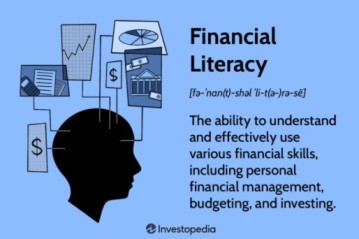आर्थिक रूप से शिक्षित होना न केवल आपके वित्तीय भविष्य को सुरक्षित करता है, बल्कि आपको सही निर्णय लेने में भी मदद करता है। वित्तीय साक्षरता (Financial Literacy) का अर्थ है पैसे का प्रबंधन, निवेश, बचत, और खर्च के तरीकों को समझना। यहाँ कुछ तरीके दिए गए हैं, जिनसे आप अपनी वित्तीय साक्षरता बढ़ा सकते हैं:
1. वित्तीय ज्ञान का अध्ययन करें
- पुस्तकें और ऑनलाइन संसाधन: विभिन्न वित्तीय पुस्तकें, लेख, और ऑनलाइन कोर्स का अध्ययन करें। “Rich Dad Poor Dad,” “The Total Money Makeover,” और “The Intelligent Investor” जैसी किताबें बेहतरीन विकल्प हैं।
- फाइनेंशियल ब्लॉग्स और पॉडकास्ट: फाइनेंस से जुड़े ब्लॉग और पॉडकास्ट को फॉलो करें, जो आपकी वित्तीय समझ को बढ़ाने में मदद करेंगे।
2. व्यक्तिगत वित्त की योजना बनाएं
- बजट बनाना: अपने मासिक खर्चों और आय का एक बजट बनाएं। इससे आपको अपने खर्चों पर नियंत्रण रखने में मदद मिलेगी।
- लक्ष्य निर्धारित करें: अपने वित्तीय लक्ष्यों को स्पष्ट करें। ये लक्ष्य आपातकालीन फंड, बचत, और निवेश के लिए हो सकते हैं।
3. निवेश के विभिन्न विकल्पों को जानें
- शेयर बाजार: शेयर बाजार और म्यूचुअल फंड में निवेश के बारे में जानकारी प्राप्त करें। इससे आपको निवेश के लाभ और जोखिम का पता चलेगा।
- रियल एस्टेट और अन्य संपत्तियाँ: रियल एस्टेट, सोना, और अन्य संपत्तियों में निवेश के विकल्पों के बारे में जानें।
4. वित्तीय प्रबंधन उपकरणों का उपयोग करें
- फाइनेंशियल एप्स: बजट बनाने और खर्चों को ट्रैक करने के लिए फाइनेंशियल एप्स का उपयोग करें, जैसे कि “Mint,” “YNAB (You Need A Budget),” या “PocketGuard”।
- सप्लाई और डिमांड: इन उपकरणों का उपयोग करके, आप अपने वित्तीय स्थिति की बेहतर समझ हासिल कर सकते हैं।
5. वित्तीय शिक्षा कार्यक्रमों में भाग लें
- सामुदायिक वर्कशॉप्स: स्थानीय सामुदायिक केंद्रों या कॉलेजों द्वारा आयोजित वित्तीय शिक्षा कार्यक्रमों में भाग लें।
- ऑनलाइन कोर्स: विभिन्न प्लेटफार्मों, जैसे कि Coursera, Udemy, या Khan Academy पर वित्तीय शिक्षा के ऑनलाइन कोर्स करें।
6. आर्थिक मामलों में अपडेट रहें
- समाचार और वित्तीय रिपोर्ट: वित्तीय समाचार चैनलों और वेबसाइटों पर नियमित रूप से अपडेट रहें। इससे आपको आर्थिक रुझानों और बाजार की स्थितियों का ज्ञान होगा।
- वित्तीय विशेषज्ञों की राय: वित्तीय विशेषज्ञों की राय और विश्लेषण पढ़ें, ताकि आप बेहतर निर्णय ले सकें।
7. प्रायोगिक अनुभव प्राप्त करें
- छोटे निवेशों से शुरू करें: अपने ज्ञान को लागू करने के लिए छोटे निवेश करें। इससे आपको अनुभव प्राप्त होगा और आप सीख सकेंगे कि निवेश कैसे काम करता है।
- वित्तीय मामलों में बातचीत करें: अपने दोस्तों और परिवार के साथ वित्तीय मामलों पर चर्चा करें। इससे आपको नए दृष्टिकोण मिलेंगे और आप अधिक जानेंगे।
8. आत्म-साक्षरता की दिशा में प्रयास करें
- फाइनेंशियल प्लानर से मिलें: यदि संभव हो, तो किसी प्रमाणित वित्तीय सलाहकार या प्लानर से मिलें। वे आपको सही दिशा में मार्गदर्शन कर सकते हैं।
- टैक्स नियमों की जानकारी: अपने देश के टैक्स नियमों और छूटों के बारे में जानें, ताकि आप सही तरीके से अपनी कर योग्य आय को प्रबंधित कर सकें।
निष्कर्ष
आर्थिक रूप से शिक्षित होना आपकी वित्तीय सुरक्षा के लिए अत्यंत महत्वपूर्ण है। वित्तीय साक्षरता बढ़ाने के लिए आपको लगातार अध्ययन और अभ्यास की आवश्यकता होती है। ऊपर दिए गए उपायों को अपनाकर, आप अपनी वित्तीय स्थिति को बेहतर बना सकते हैं और अपने भविष्य के लिए एक मजबूत आधार स्थापित कर सकते हैं। आर्थिक समझ के साथ, आप न केवल अपनी व्यक्तिगत वित्तीय समस्याओं को सुलझा सकते हैं, बल्कि दूसरों को भी इस दिशा में मदद कर सकते हैं।
